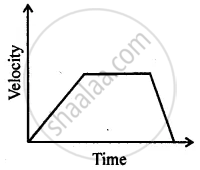Advertisements
Advertisements
Question
Find the initial velocity of a car which is stopped in 10 seconds by applying brakes. The retardation due to brakes is 2.5 m/s2.
Solution
We have to find the initial velocity.
Final velocity as the car stops after some time, (v) = 0 m/s
Acceleration for the entire journey, (a) = –2.5 m/s2
Time taken is (t) = 10 s
Let the initial velocity be (u)
We can calculate initial velocity using 1st equation of motion as, u = v – at
So initial velocity,
u = 0 – (–2.5)(10)
⇒ u = 25 m/s
APPEARS IN
RELATED QUESTIONS
Explain the meaning of the following equation of motion :v = u + at, where symbols have their usual meanings.
A body starting from rest travels with uniform acceleration. If it travels 100 m in 5 s, what is the value of acceleration ?
A car acquire a velocity of 72 km per hour in 10 second starting from rest. Find
(1) the acceleration,
(2) the average velocity, and
(3) the distance travelled in this time.
A car is travelling along the road at 8 ms-1. It accelerates at 1 ms-2 for a distance of 18 m. How fast is it then travelling ?
State how the velocity-time graph can be used to find
The acceleration of a body
Derive the following equations for uniformly accelerated motion:
(i) v = u + at
(ii) `"S = ut" + 1/2 "at"^2`
(iii) v2 = u2 + 2aS
where the symbols have their usual meanings.
When is the positive acceleration?
How can you find the following?
Velocity from acceleration – time graph.
Can you suggest a real-life example about the motion of a body from the following velocity – time graph?

Draw a velocity versus time graph of a stone thrown vertically upwards and then coming downwards after attaining the maximum height.
